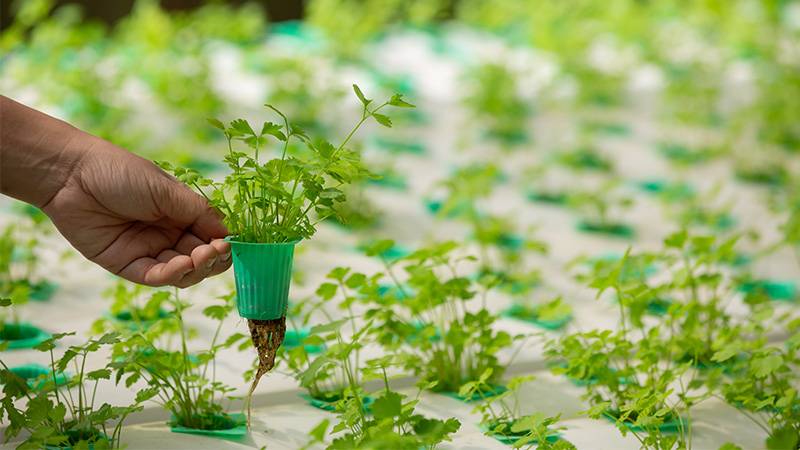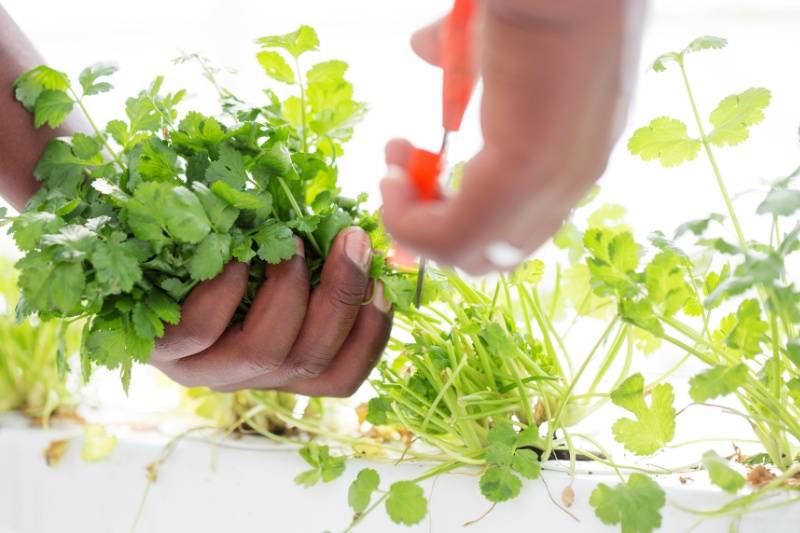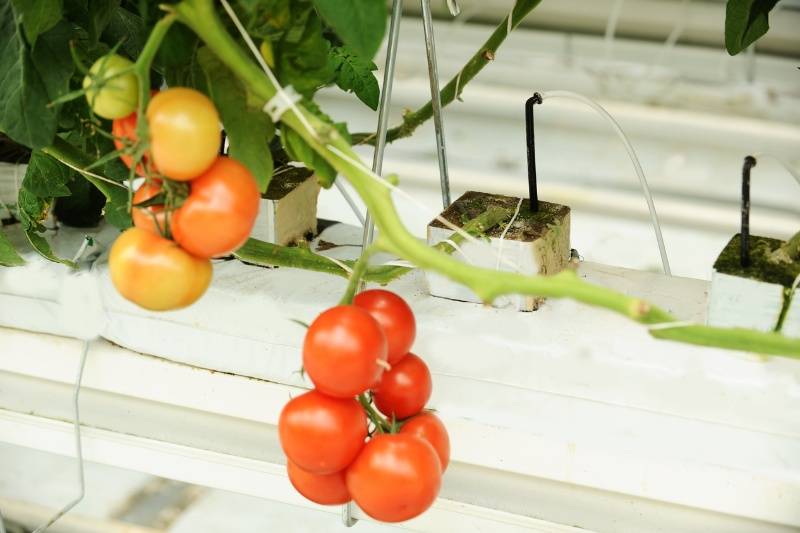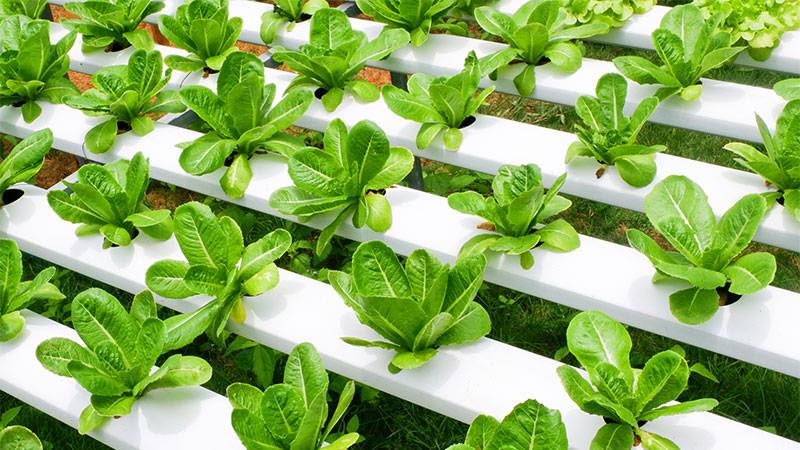Ever thought about gardening without soil? That’s hydroponics for you!
Hydroponics is a method where plants grow in a soil-less, nutrient-rich water solution. It’s efficient, uses less water, and plants often grow faster. Now, imagine combining this with a greenhouse.
That’s where the magic happens!
A hydroponics greenhouse offers a controlled environment agriculture setup, ideal for plant growth. Picture this: no more worrying about weather changes or pests ruining your crops. Plus, you can grow fresh produce all year round, even in the dead of winter. My first hydroponic tomato harvest in a greenhouse was a game-changer.
Juicy, red tomatoes in January – who would’ve thought?
In essence, hydroponics and greenhouses together create a gardening powerhouse. They boost plant growth and yield, giving you healthier plants and more bountiful harvests. It’s like giving your plants the VIP treatment!
What is Hydroponics?
Let’s cover the basics first. Simply put, it’s a method of growing plants without soil. Instead, plants thrive in a nutrient-rich water solution. This might sound futuristic, but it’s been around for centuries.
The Hanging Gardens of Babylon? Likely one of the earliest hydroponic systems! A modern hydroponic garden allows you to grow various plants without soil, offering benefits like controlled growing conditions and efficient use of space, especially for urban and short-season growers.
Hydroponic growing basics revolve around providing plants with essential nutrients directly through water. This system allows for more control over nutrient delivery, often leading to faster growth and higher yields. Traditional soil gardening relies on the quality and health of the soil, which can vary greatly. In hydroponics, you bypass soil entirely, reducing the risk of soil-borne diseases and pests.
One summer, I tried growing lettuce using hydroponics. It was amazing to see how quickly they sprouted and matured compared to my soil garden. The process was clean, efficient, and surprisingly easy to manage.
In a hydroponics greenhouse, you can further optimize plant growth by controlling temperature, humidity, and light. This setup maximizes plant health and productivity, making hydroponics a revolutionary approach to gardening.
Hydroponics is not just a high-tech gimmick. It’s a proven method that offers numerous benefits over traditional soil gardening, from faster growth to greater control over plant health.
The Magic Behind Nutrient Solutions
Nutrient solutions are the lifeblood of hydroponic systems.
These specially formulated mixtures are designed to provide plants with every vital mineral and element they would typically derive from soil. From nitrogen to potassium, from phosphorus to essential trace elements, everything a plant needs is dissolved in the water they’re bathed in.
But it’s not just about dunking plants in a nutrient bath. The pH balance in hydroponics is crucial. Too acidic or too alkaline, and plants can’t absorb the nutrients they need. Regular monitoring and adjustments ensure the solution remains optimal for plant uptake.
Additionally, oxygenation in hydroponics is vital. Roots need oxygen, and in hydroponics, this is often achieved through air stones or hydroponic pumps, ensuring roots don’t drown but thrive.
Benefits of Using a Greenhouse for Hydroponics

Using a greenhouse for hydroponic gardening has several fantastic benefits. First and foremost, it provides a controlled environment. You can manage temperature, humidity, and light, creating the perfect conditions for your plants. It’s like giving your plants a five-star hotel experience!
Another major benefit is the extended growing season. In a greenhouse, you’re not at the mercy of the seasons. I remember harvesting strawberries in the middle of winter, a luxury made possible by my hydroponic greenhouse. You can grow fresh produce all year round, no matter the weather outside.
Pest protection is another huge advantage. Greenhouses act as a barrier against common garden pests. This means fewer chemicals and a healthier garden. I used to struggle with aphids attacking my lettuce, but since switching to a hydroponic greenhouse, those worries are a thing of the past.
Additionally, hydroponic systems in a greenhouse can lead to optimal growth and higher yields. With precise nutrient delivery and ideal growing conditions, plants can thrive like never before. The results? Bigger, healthier plants and more produce. You can also grow more plants in the same space, maximizing your greenhouse’s potential.
The benefits of a hydroponics greenhouse are hard to beat. From a controlled environment to an extended growing season and better pest protection, it’s a game-changer for any gardener.
Plus, who doesn’t love fresh, home-grown veggies all year long?
Types of Hydroponic Systems for Greenhouses
When setting up a hydroponic greenhouse, choosing the right hydroponic growing systems is crucial.
Let’s explore four popular types:
- Nutrient Film Technique (NFT)
- Deep Water Culture (DWC)
- Aeroponics
- Wick System

Nutrient Film Technique (NFT)
The Nutrient Film Technique (NFT) involves a thin film of nutrient-rich water flowing continuously over plant roots. This system is ideal for plants with smaller root systems, like lettuce and herbs.
I once tried growing lettuce with NFT in my greenhouse. The growth was impressive, but a pump failure taught me the importance of having a backup plan. A reliable water pump is crucial in ensuring continuous nutrient flow to prevent root drying and support plant growth.
Pros
Cons
- Efficient use of water and nutrients.
- Continuous nutrient supply promotes rapid growth.
- Easy to monitor and adjust nutrient levels.
- Roots can dry out quickly if the pump fails.
- Not suitable for larger plants with extensive root systems.
Deep Water Culture (DWC)
Deep Water Culture (DWC) suspends plant roots in a nutrient-rich solution, continuously oxygenated with an air pump. This system is straightforward and effective for a variety of plants, including larger ones like tomatoes and cucumbers.
In my greenhouse, DWC was a hit with tomatoes. But keep a close eye on water temperature to avoid root rot.
Pros
Cons
- Simple setup and maintenance.
- Provides constant access to nutrients and oxygen.
- Suitable for a wide range of plants.
- Requires continuous aeration; pump failure can be disastrous.
- Water temperature control is crucial to prevent root diseases.
Aeroponics
Aeroponics involves misting plant roots with a nutrient solution at regular intervals. This method promotes rapid growth and maximizes nutrient uptake, making it ideal for high-value crops like herbs and leafy greens.
Pros
Cons
- Maximizes oxygen access to roots, promoting faster growth.
- Uses less water compared to other systems.
- Ideal for small spaces and vertical setups.
- High initial setup cost and technical know-how required.
- Vulnerable to power outages; roots can dry out quickly.
Wick System
The Wick System is the simplest form of hydroponics. It uses a wick to draw nutrient solution from a reservoir to the plant roots. This passive system is great for beginners and small plants like herbs.
I started my hydroponics journey with the Wick System, growing mint and basil. It was a great way to learn the basics without much risk.
Pros
Cons
- No moving parts, making it very low maintenance.
- Ideal for beginners due to its simplicity.
- Inexpensive and easy to set up.
- Not suitable for larger plants with high nutrient demands.
- Slower growth rate compared to active systems.
Each hydroponic system offers unique benefits and challenges. Nutrient Film Technique, Deep Water Culture, aeroponics, and the Wick System all provide different approaches to hydroponic gardening in a greenhouse.
Choose the one that best fits your needs, resources, and gardening goals.
Setting Up Your Hydroponic Greenhouse

Setting up a hydroponic greenhouse may seem daunting, but it’s quite manageable with the right steps.
Here’s a step-by-step guide to get you started. Using a high-quality hydroponic greenhouse kit can help you get the most out of your harvests by creating optimal growing conditions, streamlining water delivery, reducing the risk of pests and disease, and enabling automation for better and larger year-round yields.
Selecting the Right Location
Choosing the perfect spot for your greenhouse is crucial. Aim for a location with plenty of sunlight. At least six hours of direct sunlight daily is ideal. If natural light is limited, consider supplemental grow lights.
I remember placing my greenhouse where it caught the morning sun. It made a huge difference in plant growth.
Materials Needed
To set up your hydroponic greenhouse, you’ll need the following materials:
- Greenhouse structure: Choose between a pre-fabricated greenhouse or build your own.
- Hydroponic system: Pick the system that best suits your needs (NFT, DWC, aeroponics, or Wick System).
- Grow lights: Essential if your location lacks sufficient natural light.
- Water and nutrient reservoir: Ensure it’s large enough to sustain your plants.
- Air pump and tubing: Crucial for oxygenating the nutrient solution in systems like DWC.
- pH and EC meters: To monitor and adjust nutrient levels.
- Growing medium: Options include rock wool, clay pellets, perlite, or coconut coir.
- Liquid fertilizer: Important for maintaining proper nutrient levels and adjusting nutrient concentrations and acidity.
Basic Setup Instructions
- Assemble the Greenhouse: Follow the manufacturer’s instructions if you have a pre-fabricated kit. Ensure the structure is sturdy and secure.
- Install the Hydroponic System: Set up your chosen hydroponic system inside the greenhouse. Place it where plants will receive optimal light.
- Set Up the Reservoir: Position the water and nutrient reservoir. Connect the hydroponic system to the reservoir using appropriate tubing.
- Install Grow Lights: If needed, hang grow lights above the hydroponic system. Ensure they cover the entire growing area.
- Add Growing Medium: Fill your hydroponic system’s containers with the chosen growing medium.
- Mix Nutrient Solution: Prepare the nutrient solution according to the manufacturer’s guidelines. Fill the reservoir.
- Check pH and EC Levels: Use pH and EC meters to adjust the nutrient solution to optimal levels for your plants.
- Plant Your Seedlings: Place seedlings in the growing medium. Ensure their roots can access the nutrient solution.
- Set Up the Air Pump: Connect the air pump to the reservoir to oxygenate the water. This is especially important for systems like DWC.
In my first setup, I overlooked the importance of pH levels. My plants struggled until I invested in a good pH meter. Regular monitoring makes a big difference!

Read More:
Choosing the Right Plants

Selecting the right plants for your hydroponic greenhouse is crucial for a successful harvest.
Hydroponically grown plants, which are grown without soil in water with dissolved nutrients, tend to grow faster and larger than traditional counterparts due to the controlled nutrient solutions and optimized root conditions.
Certain plants thrive in hydroponic systems, making them ideal choices for beginners and seasoned gardeners alike.
Leafy Greens

Leafy greens, such as lettuce, spinach, and kale, are among the best plants for a hydroponic greenhouse. They grow quickly and require minimal space. I started with lettuce, and the rapid growth was rewarding.
Tips:
- Choose varieties that mature quickly.
- Monitor nutrient levels closely to avoid deficiencies.
- Harvest leaves regularly to encourage continuous growth.
Herbs

Herbs like basil, mint, and cilantro are excellent choices for hydroponic gardening. They are easy to grow and add fresh flavors to your dishes. My basil plants grew so well that I had to share with friends and family.
Tips:
- Opt for popular culinary herbs that you frequently use.
- Prune regularly to promote bushier growth.
- Ensure proper light exposure for the best flavor.
Tomatoes

Tomatoes are a favorite among hydroponic gardeners. They require a bit more care but reward you with juicy, flavorful fruits. I remember the excitement of harvesting my first hydroponic tomatoes – they tasted amazing!
Tips:
- Choose compact, determinate varieties for smaller spaces.
- Provide support for the plants as they grow.
- Maintain consistent nutrient and water levels to prevent issues like blossom end rot.
Climate and Personal Preference
When choosing plants, consider your local climate and personal preferences. For instance, if you live in a cooler region, leafy greens might perform better than heat-loving plants like peppers.
Tips:
- Research plant varieties that thrive in your climate.
- Start with plants you enjoy eating and are excited to grow.
- Experiment with different plants to discover what works best in your setup.
Conclusion
Setting up a hydroponic greenhouse is an exciting and rewarding endeavor. By combining the principles of hydroponics with the controlled environment of a greenhouse, you can achieve year-round cultivation, increased yields, and efficient resource use.
We explored various hydroponic systems like NFT, DWC, aeroponics, and the Wick System, each with unique advantages. Setting up your hydroponic greenhouse involves careful planning and the right materials.
Choosing the right plants, such as leafy greens, herbs, and tomatoes, ensures a productive garden.
Starting your own hydroponic greenhouse may seem challenging, but the long-term benefits are well worth the effort. You’ll enjoy fresh, home-grown vegetables and contribute to a more sustainable gardening method.
So why wait? Dive into the world of hydroponics and experience the satisfaction of growing your own food.


